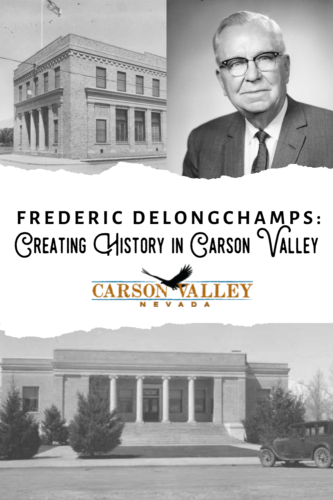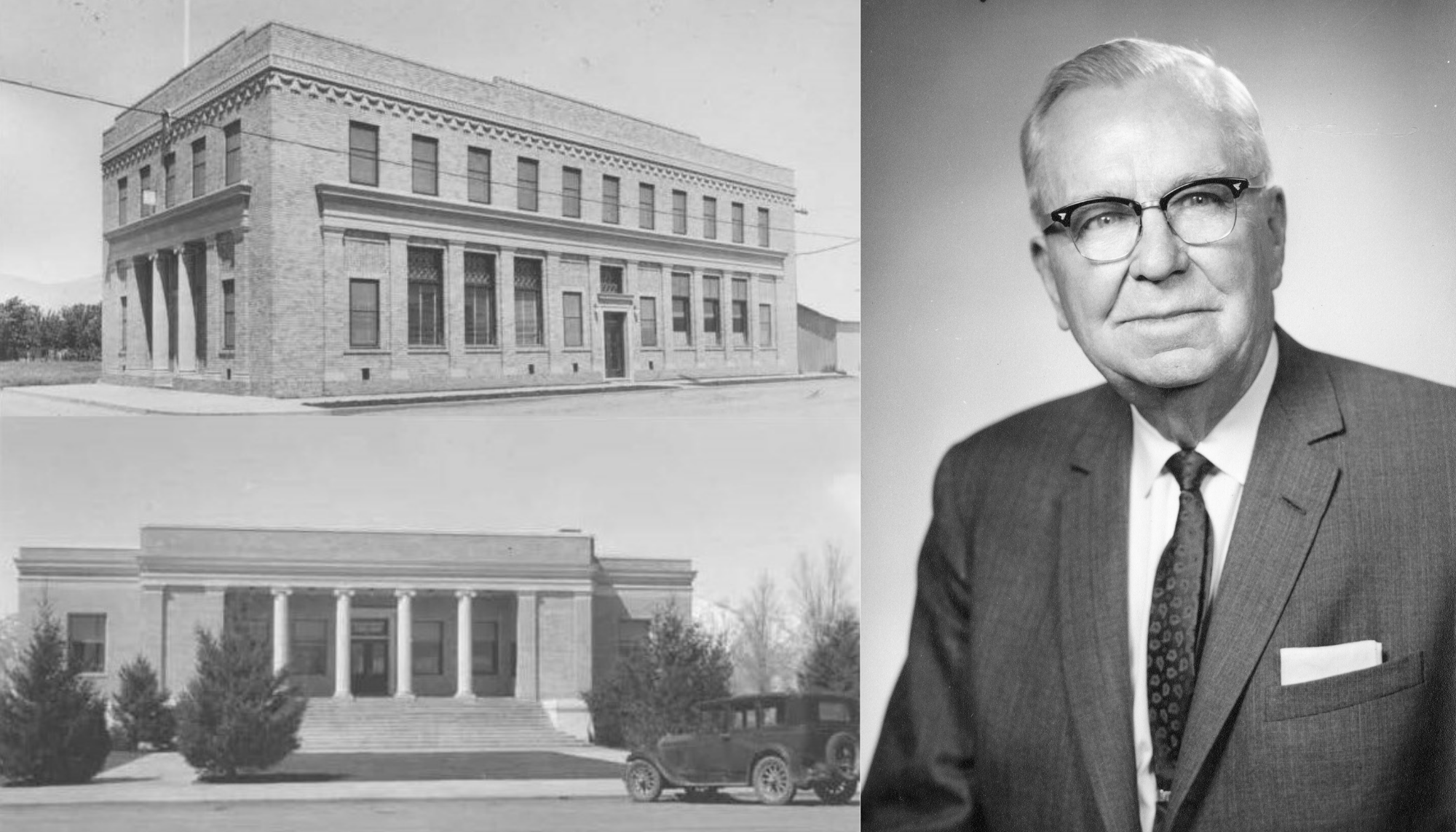“Your public buildings would do credit to a community twice the size”.
Coming from some head honchos of the time, that was quite the compliment.
It was 1916, and a group of railroad managers—including the San Francisco-based vice president of Southern Pacific—made this remark during a visit to Carson Valley. The buildings they were admiring must’ve stuck out like fine china at a Tupperware party, particularly in a place where livestock outnumbered people. And yet there they stood, monumentally stoic brick structures striking not only for their grand scale, but also their symmetry and simple geometry. Even if math isn’t your forte, you are still likely to notice them over a century later too, because they are just neat.
Many a Nevadan has heard of a fellow named Frederic DeLongchamps, the architect responsible for not only several prominent buildings in Carson Valley but throughout the state. He made his mark on Carson Valley with a Neo-Classical style which, combined with their importance to local history and politics, earned each of these a listing on the National Register of Historic Places.
We’ll get to that, but first, let’s look at the man behind the plans.
The Man Himself
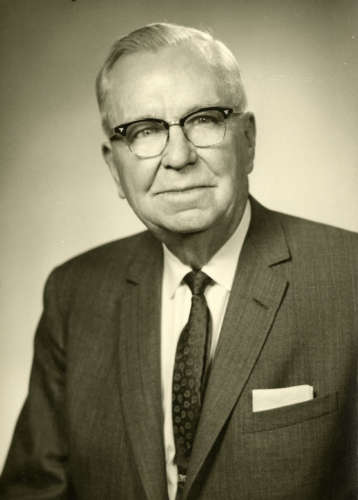
[UNRS-P1989-09-115] Special Collections and University Archives Department, University of Nevada, Reno
Anyway, Felix and Exilda had emigrated separately from Quebec in the 1860’s. Felix became a lumber merchant, cutting timber from Markleeville to Incline Village for use in, what else, the Comstock mines. After the couple wed, they moved to Reno and Felix became a well-known builder. Fred helped dear old dad erect houses, giving him practical knowledge of construction techniques that he would unknowingly tuck into his back pocket for future use. Maybe the Comstock era excited him (easily understandable) but for whatever reason, Fred was incredibly interested in mining and graduated from the University of Nevada in 1904 with a degree in Mining Engineering. His yearbook picture was accompanied by the quote, “Men of few words are the best men”.

Note the old spelling of his last name.
By all accounts, that fit Fred to a ‘T’. According to his unpublished autobiography, this was partially since his parents only spoke French. Fred didn’t learn English until he started school and because he was scared to use the wrong words, he simply didn’t use many of them at all. He was also quoted by reporters once saying that he preferred to “let the buildings he designed speak for him” and boy, did they.
You would think Fred graduated and jumped feet-first into the architect world. After all, he had the diploma, the drafting classes, construction experience and let’s not forget natural talent on his side. Yet, he still dreamed of the mining industry (gold fever is a very real thing, folks), so his first job after graduation was in Inyo County as an Assistant Mining Superintendent. Poor Fred’s dreams were dashed, however, when he developed a lung ailment and was warned by a doctor not to work underground any longer — effectively ending his mining career.
As they say, when one door closes…
Fred returned to Reno and made a life pivot, staying busy designing small projects. In 1909, he won a competition to design the new Washoe County Courthouse, a building that would become the largest and most sophisticated county structure in Nevada. After that little project was completed, he went to San Francisco to further his experience and knowledge of formal architectural design, becoming a licensed California architect in 1911. When he got back to Reno, his services were in demand and he got busy, with more than 100 commissions during the next decade.
Enter, Carson Valley
Well, old Fred was “building” quite the reputation for himself and concurrently, Carson Valley was going through some changes that prompted the need for just such an architect. The Genoa fire of 1910 had destroyed much of the town, which led to the transition of the county seat and the need for a new Douglas County Courthouse. There was, however, quite the kerfuffle between the towns of Minden and Gardnerville on just where that courthouse would be built. Of course, both towns wanted this honor, but eventually struck a compromise: Minden would be home to the new Douglas County Courthouse and in return, Fred would design the Douglas County Highschool for Gardnerville.
All’s well that ends well; because Fred was keyed into the drama playing out between the two towns, he eased any lingering resentments by designing the buildings to be extraordinarily similar, both in design and scale. Completed in late 1915, they both opened to great praise and adoration.
After Minden scored the county seat, another very important Fred entered the scene. H.F. “Fred” Dangberg, Jr. commissioned DeLongchamps to design four commercial and industrial buildings (the Minden Butter Manufacturing Company, Farmers Bank of Carson Valley, Minden Wool Warehouse, and the Minden Inn), as well as several structures on the infamous Dangberg Home Ranch. The two Freds proved to be a pair for the history books, and the buildings would define the architectural character of Minden that still charms today. They became friends, and DeLongchamps would even stay at the Home Ranch with the Dangberg family.
Much later, he would return to Carson Valley and design remodels of residences and older buildings such as the Adaven and Overland Hotels, as well as the former St. Gall Catholic church. In the 1940s-1950s, he designed the former Methodist church (now Walton’s) and Trinity Lutheran Church and its parsonage.
Fred’s career as Nevada’s premiere architect would go on to span a dazzling 57 years and because of that, his styles changed with the times from Neo-Classicism to Arts and Crafts to Art Deco to Modernism. In 1919, he was appointed as the first Nevada State Architect, the only person to ever hold that title in history as the position was eliminated in 1926. So he really was, the guy, and he remained that way. He retired from his profession at 81 years young and though he passed away five years later, his incredible body of work lives on. His buildings continue to stand out proudly in Carson Valley and are loved and appreciated by all.
DeLongchamp’s Historic Gems of Carson Valley
In order to preserve DeLongchamps’ incredible legacy, a comprehensive study was begun in 1981 to identify his works. This project landed these six Carson Valley properties on the National Register of Historic Places.
Douglas County Courthouse
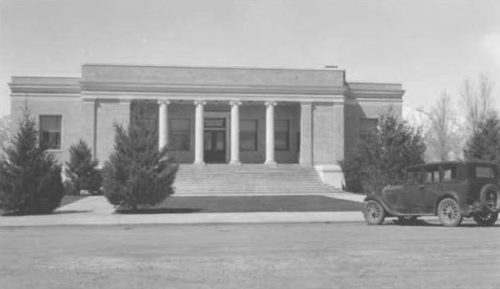
Photograph courtesy of Douglas County Historical Society, Nevada
Ah, the building that originally brought Frederick DeLongchamps to Carson Valley. When the county seat was transferred and it was decided that Minden would be the home of the new courthouse (remember the kerfuffle), Dangberg Land and Livestock Company donated an appropriate lot, with one minor issue. It wasn’t located in Minden. Oops. Not to worry though, the County Commissioners were able to approve an amended map to include it in the town. In January 1916, the first meeting was held in the new courthouse which included county offices, courtrooms, meeting rooms and jail facilities in the basement. Today, the building is still considered (along with the high school, of course), to be one of the best expressions of the Neo-Classical style by DeLongchamps.
Fun Fact: After the U.S. entered World War I in 1917, the courthouse became the hub of military activity in the valley. Patriotism was in full force as groups of young men were called up to serve, and the community residents would gather in front of the courthouse to applaud them. Then the men, accompanied by the residents and a fife and drum band, would march together to the Minden train depot where they would see the soldiers off. Later in 1922, a bronze plaque commemorated the war veterans and the role of the courthouse. It was the first World War I memorial in the state of Nevada!
Douglas County High School
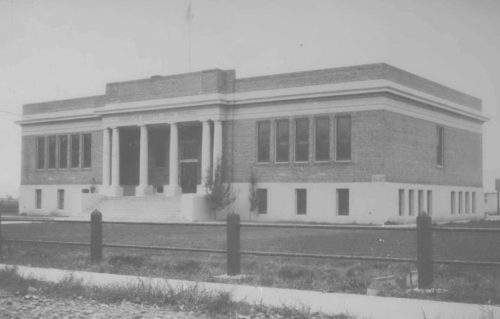
Photograph courtesy of Douglas County Historical Society, Nevada
Of course, we know this beautiful building to be the result of the compromise with Minden and it’s somewhat difficult to tell the two apart, due to Fred’s sensitivity in the matter. A brand spankin’ new high school was a pretty great addition to Gardnerville and it would continue to serve as such until 1958, when it transitioned to Junior High. The building closed in 1982 after it no longer met code requirements.
Five years later, the school district was considering demolishing the old High School, when the Douglas County Historical Society stepped in and signed a 100-year lease at the whopping price tag of $1/year. Much of the interior was modified (as was the courthouse) and it took years of work to strengthen the integrity of the old building. On August 19, 1995, the building reopened with a new name: the Carson Valley Museum and Cultural Center, still in operation today. The museum wonderfully preserves memories of the old High School, the valley’s agricultural roots and Basque heritage, along with several other intriguing exhibits.
Fun Fact: In addition to all the great things you can find in the Museum and Cultural Center, there is an east side corner office where Visit Carson Valley (the local tourism office) and this writer are waiting to greet you!
Farmers Bank of Carson Valley
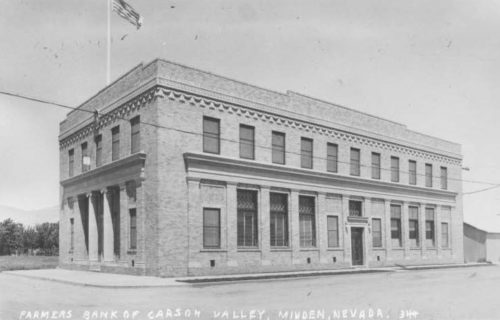
Photograph courtesy of Douglas County Historical Society, Nevada
The Farmers Bank of Carson Valley was established between 1916 and 1918, by (who else?) the Dangberg family and a few other prominent businessmen. It replaced the original bank that is now home to a very fun bar in Carson Valley, the Corner Bar. After outgrowing that facility, Dangberg commissioned the new structure that also included offices for the Dangberg Land and Livestock company, along with some other offices for rent. Because it was well capitalized, the Farmers Bank survived the Great Depression and was one of the first in the nation to reopen in 1933 after the “bank holiday” by President Roosevelt.
Eventually, the bank merged with another financial institution and was converted into offices. Its Classical Revival style features the use of terra cotta garlands and tiles on the entrance façade, red bricks on the north and east sides and beige bricks on the south and west. Talk about a beautifully unique combo!
Fun fact: In the 1930’s, the Forest Service was one of the renters of the office space inside the Farmers Bank. Four times a day, an employee would clamber up on the roof and scan the surrounding mountains, looking for any signs of fire with a high-powered field glass. This made for quite the fancy look-out tower. It also made for a great movie set; the 1973 film “Charley Varrick” had a bank robbery scene filmed inside.
Minden Wool Warehouse
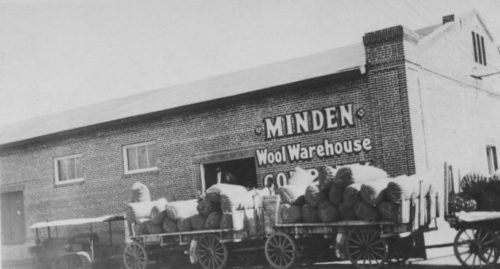
Photograph courtesy of Douglas County Historical Society, Nevada
Driving north on 395 through Minden, you are bound to notice what was once the Minden Wool Warehouse. Constructed in 1916 as a storage facility (geez, don’t you wish your storage was this beautiful?) for the Dangberg Land and Livestock Company, it was designed to house potatoes and wool, of course. Imagine, an entire building for spuds and sheep hair. Of course, they weren’t thrown in together haphazardly, the potatoes were in the lower level and the wool was upstairs. The size of the rectangular warehouse reflects the scale of these industries at one time. Until about the 1940s, the valley was a large potato producer, but competition from around the country ended the commercial growing in the area.
In 1964, the Dangberg Company had moved their offices from the Farmers Bank building to the warehouse. Currently, the Prism Art Gallery resides in the old Wool Warehouse and is open to the public.
Fun Fact: This entire building was constructed for $15,000! Can you imagine?
Minden Butter Manufacturing Company
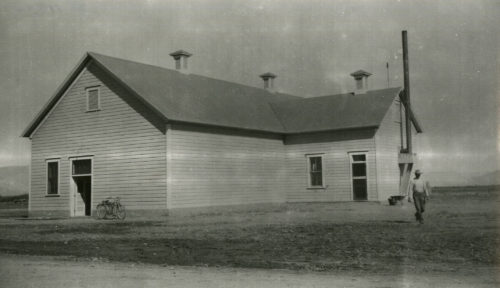
Original wooden structure [UNRS-P1533-1], Special Collections and University Archives Department, University of Nevada, Reno
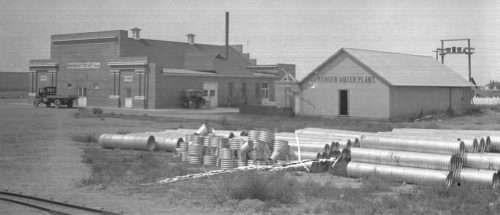
Minden Butter Manufacturing Company, designed by Frederick DeLongchamps. Photo courtesy of the Dangberg Home Ranch Historic Park.
Created to process the cream from Carson Valley dairy farmers, the Minden Butter Manufacturing Company originally operated out of a wooden building. However, because of increased production and a new California law requiring butter to be pasteurized, Dangberg commissioned DeLongchamps to design a modern brick facility around the original structure. This allowed the production to increase by 50% the first year and future upgrades would keep the creamery one of Minden’s main industries throughout the first half of the 20th century.
In 1946, milk producers (the farmers, not the cows) formed a cooperative and took control of the company. Because of the shared ownership, the dairy farmers accepted low prices to stay in business. However, a large and more modern dairy opened near Genoa in 1958, paying farmers more for their products. This, combined with lack of funds to upgrade the Minden facility, led to its closure in 1961.
In 1969, Don Bently purchased the property and moved his Bently-Nevada operations to the facility. Although the original windows were modified and the facility was greatly enlarged at the rear, he kept the historic façade. In 2015, son Chris Bently adopted a similar strategy. The entire back of the creamery building was removed; however, the original façade was preserved.
Fun Fact: By 1915, the monthly output of the original wooden facility was more than any other Nevada creamery. The combination of a high-quality product and the proximity of the V&T Railway was a recipe for success. It made it easy to ship the butter outside of the area and San Francisco was a major market – maybe butter was the real San Francisco treat! It was said that some of the butter was even shipped to China.
Minden Inn
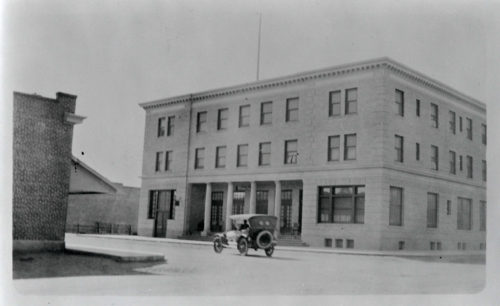
[UNRS-P1984-29_45], Special Collections and University Archives Department, University of Nevada, Reno.
The hotel boasted a ball and dining room, and soon became the center of social activity in the valley. The easy access to alcohol and legal gaming may have contributed to the later downfall of Fred Dangberg, as it was claimed that his large gambling and other debts led to the Dangberg Company selling off the Minden Inn in 1923.
Over the years, many changes would be made to the Inn and it would change hands a little like a game of hot potato. During World War II, it would be used to house Army Air Corp men attending flight training at the Minden Airport. Later, it was opened as the Carson Valley Hospital though this would close three years later. It was leased as a laundry, dining room, coffee shop, cocktail lounge, and housing option for those in the service industry, to name a few.
Eventually, the Minden Inn was renovated and leased and later purchased by the county for office space.
Fun Fact: In 1921, a story popped up in the newspapers that the manager of the Minden Inn was unable to find the key to open the house safe that protected the valuables of the guests. Keeping a cool head, he came up with a unique solution. He called up the Nevada State Prison Warden who soon arrived with two safe-cracking convicts who made quick work of the strong box. Problem solved!
Frederic DeLongchamp’s buildings continue to charm all those who set eyes on them today and force you to stop and wonder, “if the walls could talk…”
Make a date with history and check out these six buildings with our Google Maps list here.
Visit Carson Valley would like to extend its sincerest gratitude to Debbe Nye of the Douglas County Historical Society, whose exhaustive and dedicated research not only made this possible, but also served as the meat and potatoes of this article.
